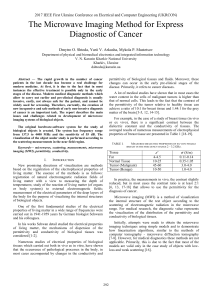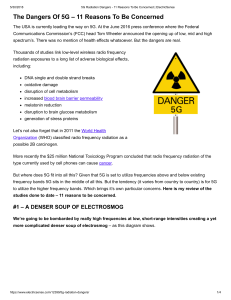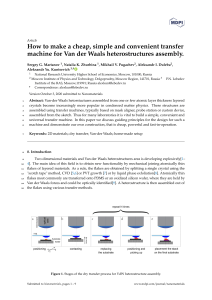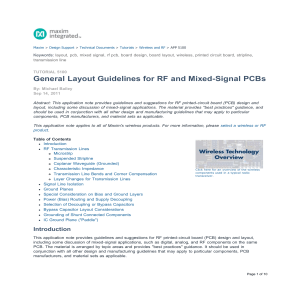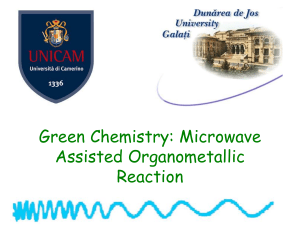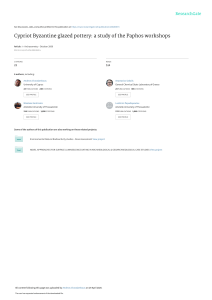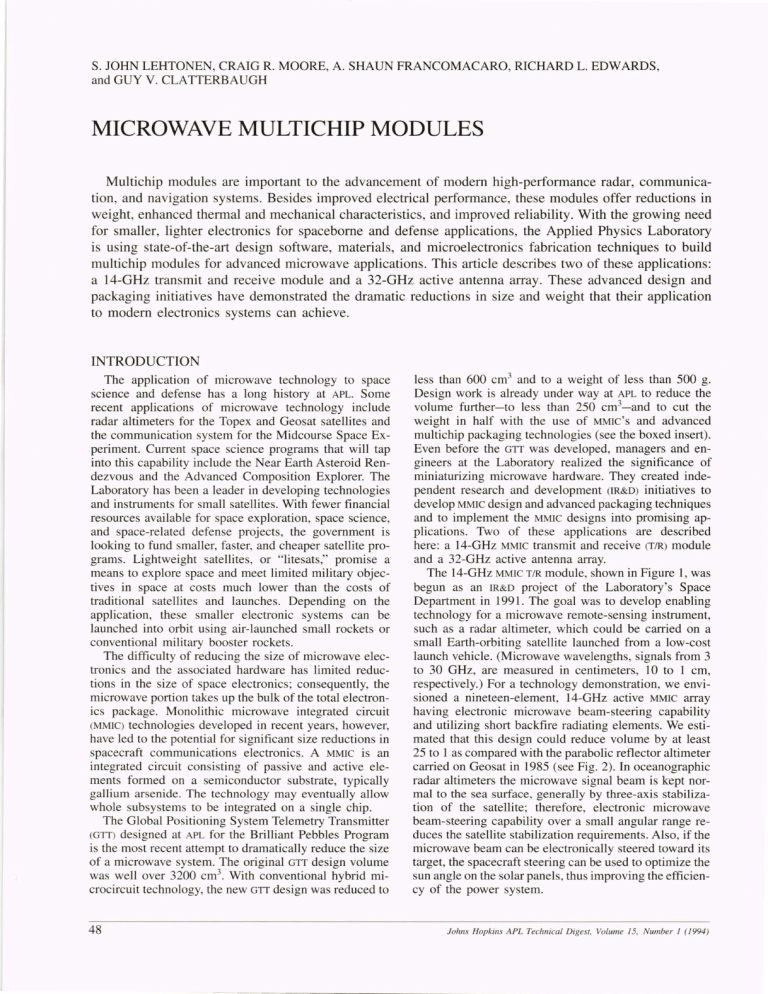
S. JOHN LEHTONEN, CRAIG R. MOORE, A. SHAUN FRANCOMACARO, RICHARD L. EDWARDS, and GUY V. CLATTERBAUGH MICROWAVE MULTICHIP MODULES Multichip modules are important to the advancement of modern high-performance radar, communication, and navigation systems. Besides improved electrical performance, these modules offer reductions in weight, enhanced thermal and mechanical characteristics, and improved reliability. With the growing need for smaller, lighter electronics for spaceborne and defense applications, the Applied Physics Laboratory is using state-of-the-art design software, materials, and microelectronics fabrication techniques to build multichip modules for advanced microwave applications. This article describes two of these applications: a 14-GHz transmit and receive module and a 32-GHz active antenna array. These advanced design and packaging initiatives have demonstrated the dramatic reductions in size and weight that their application to modern electronics systems can achieve. INTRODUCTION The application of microwave technology to space science and defense has a long history at APL. Some recent applications of microwave technology include radar altimeters for the Topex and Geosat satellites and the communication system for the Midcourse Space Experiment. Current space science programs that will tap into this capability include the Near Earth Asteroid Rendezvous and the Advanced Composition Explorer. The Laboratory has been a leader in developing technologies and instruments for small satellites. With fewer financial resources available for pace exploration, space science, and space-related defense projects, the government is looking to fund smaller, faster, and cheaper satellite programs. Lightweight atellites, or "litesats," promise a means to explore space and meet limited military objectives in space at costs much lower than the costs of traditional satellites and launches. Depending on the application, these smaller electronic systems can be launched into orbit using air-launched small rockets or conventional military booster rockets. The difficulty of reducing the size of microwave electronics and the associated hardware has limited reductions in the size of space electronics; consequently, the microwave portion takes up the bulk of the total electronics package. Monolithic microwave integrated circuit (MMIC) technologies developed in recent years, however, have led to the potential for significant size reductions in spacecraft communications electronics. A MM1C is an integrated circuit consisting of passive and active elements formed on a semiconductor substrate, typically gallium ar enide. The technology may eventually allow whole subsystem to be integrated on a single chip. The Global Positioning System Telemetry Transmitter (GTI) designed at APL for the Brilliant Pebbles Program is the most recent attempt to dramatically reduce the size of a microwave ystem. The original GTI design volume was well over 3200 cm3 . With conventional hybrid microcircuit technology, the new GTI design was reduced to 48 less than 600 cm 3 and to a weight of less than 500 g. Design work is already under way at APL to reduce the volume further-to less than 250 cm3-and to cut the weight in half with the use of MMIC'S and advanced multichip packaging technologie (see the boxed insert). Even before the GTI was developed, managers and engineers at the Laboratory realized the significance of miniaturizing microwave hardware. They created independent research and development (IR&D) initiatives to develop MMIC design and advanced packaging techniques and to implement the MMIC designs into promising applications. Two of these applications are described here: a 14-GHz MMIC transmit and receive (T/R) module and a 32-GHz active antenna array. The 14-GHz MMIC TIR module, shown in Figure 1, was begun as an !R&D project of the Laboratory's Space Department in 1991. The goal was to develop enabling technology for a microwave remote-sensing instrument, such as a radar altimeter, which could be carried on a small Earth-orbiting satellite launched from a low-cost launch vehicle. (Microwave wavelengths, signals from 3 to 30 GHz, are measured in centimeters, 10 to 1 cm, respectively.) For a technology demonstration, we envisioned a nineteen-element, 14-GHz active MMIC array having electronic microwave beam-steering capability and utilizing short backfire radiating elements. We estimated that this design could reduce volume by at least 25 to 1 as compared with the parabolic reflector altimeter carried on Geosat in 1985 (see Fig. 2). In oceanographic radar altimeters the microwave signal beam is kept normal to the sea surface, generally by three-axis stabilization of the satellite; therefore, electronic microwave beam-steering capability over a small angular range reduces the satellite stabilization requirements. Also, if the microwave beam can be electronically steered toward its target, the spacecraft steering can be used to optimize the sun angle on the solar panels, thus improving the efficiency of the power system. Johns Hopkins A PL Technical Digest, Volume 15, Number 1 (1994) A QUICK TUTORIAL ON MULTICHIP MODULES What are multichip modules? The term multichip module typically reserved for a highly integrated, functional circuit block that consists of two or more integrated circuits (lc's)-generally bare IC chips-interconnected on a common substrate. In most MCM applications, the substrate conductor wiring is formed in multiple layered structures separated by alternating layers of dielectric. Openings in the dielectric layers, called vias, electrically connect the various wiring layers. The wiring density and surface area utilization are usually much higher than for conventional hybrid circuits and printed wiring board technologies. The IC chips and passive components are usually attached to the top surface of the substrate. The assembled substrate is then placed in a package as a fully interconnected subsystem. Typical circuit applications for MCM ' S include central processing units, digital signal processing units, and random access memory modules. Multichip packaging provides one means for achieving shorter interconnects, higher chip densities, and improved system performance. The three major categories of multichip modules are MCML (Laminate), MCM-C (Ceramic), and MCM-D (Deposited): MCM-L (Laminate): Copper conductors and thin organic laminate-based dielectrics are used to fabricate the multilayer substrate using printed wiring board technologies. These modules are often called "chip-on-board" modules. MCM-C (Cer amic) : Sheets of unfired ceramic are screen printed with thick-film conductor paste, laminated, and then co-fued. Two types of co-fireable ceramic are available for MCM ' S: high-temperature co-fireable ceramic (HTCC), which is typically 96% alumina, and low-temperature co-fireable ceramic (LTCC), which is a mix of alumina-filled glasses and crystallizable ceramics. MCM-D (Deposited): This technology uses high-resolution, photolithographic methods to form alternating layers of thin metal and polymer dielectric that are deposited and then patterned. These MCM ' S have the highest interconnect density of the MCM types and are the most expensive to manufacture. In most MCM applications the substrate is mounted into a separate microelectronics package, generally made of metal or ceramic. The package holds and protects fragile microelectronic components. A traditional package has a cavity (a hollowed out area) for attaching the components (Ic's, resistors, capacitors, and substrates). The package walls or floor have feedthroughs for electrically connecting the internal circuitry to the external circuitry. With MCM-C, the ability to fabricate the top-level circuitry within a cavity permits the substrate also to function as a package. Low-temperature co-fireable ceramic technology is used because it has the capacity to provide multilayered, buried (MCM) is The 32-GHz active antenna array (Fig. 3) was the culmination of a two-year !R&D project in the Space Department to explore waveguide and antenna mode coupling techniques for integrated millimeter-wave modules. (Millimeter-wave wavelengths, signals from 30 to Johns Hopkins APL Technical Digest, Volume 15, Number I (1994) electrical bias connections for IC chips mounted to the substrateS; it allows a hermetic housing with controlled impedance module inputs and outputs; and its thermal coefficient of expansion (TCE) is well matched to that of the IC'S and alumina substrates. High-temperature co-fireable ceramic technology can offer the functionality that the low-temperature variety provides. It also has somewhat better mechanical strength, a higher bulk thermal conductivity, and improved dielectric loss characteristics. The manufacturing costs are quite high, however, because of high equipment and initial tooling costs, and the turnaround time can be extremely long. An MCM-C substrate using LTCC material can be fabricated economically and reliably using many of the same processes and much of the same equipment that hybrid microcircuit manufacturers now use for conventional thick-film substrates. Because LTCC technology permits use of existing equipment to lower manufacturing costs and takes advantage of in-house fabrication capability to provide rapid turnaround, it represents the more attractive alternative for rapid prototyping of MCM' S. Low-Temperature Co-Fireable Ceramic Technology: Thermal and Mechanical Considerations The thermal conductivity of the module is often a critical consideration in module design. The low thermal conductivity of the LTCC can be countered effectively with the use of thermal vias. Thermal vias typically consist of an array of holes in the dielectric layers that are solidly filled with gold or silver conductor material. The vias are located beneath the mounting locations in active devices that need cooling. Figure 4 in the text shows the heat path that the thermal vias provide away from a high-heat-dissipating die. The use of thermal vias in LTCC packages affects the hermeticity of the package. In applications where a hermetic package is required, the thermal vias must be sealed. Sealing can be done by metallizing the bottom side of the module where the thermal vias are exposed and brazing a thin metal sheet to the module. This metal should have a low TCE, just slightly larger than that of the fued ceramic. The slightly larger TCE tends to maintain the ceramic in compression. As with most ceramic materials, creep fracture due to subcritical crack propagation can occur when these materials are loaded in tension .6 Gold-plated, nickelclad molybdenum is an example of one suitable choice that possesses a good thermal conductivity and can also serve as a heat spreader. The top opening to the package cavity can be hermetically sealed by brazing a metallic lid similar to a seal ring to the opening. The seal ring is a flat narrow band of metallization applied to the top periphery of the LTCC package during substrate fabrication . 300 GHz, are measured in millimeters, 10 to 1 mrn, respectively.) The objective was to analyze various schemes for injecting a millimeter-wave signal onto a waveguide or a radiating element. We wanted the capacity to generate transmitting power of several tens of watts 49 s. 1. Lehtonen et al. Volume: 0.55 m3 r Volume: 0.02 m3 0.04m * ~----- 0.80 m .1 Figure 2. Projected volume reduction of a microwave altimeter. The Geosat integrated microwave altimeter (top) has a volume of 0.55 m3 ; the array of the 14-GHz monolithic microwave integrated circuit transmit and receive module (bottom) is only 0.02 m3 . Figure 1. Waveguide-coupled 14-GHz monolithic microwave integrated circuit transmit and receive module built using a lowtemperature co-fired (LTCC) ceramic process. Lower panel is a close-up of the LTCC assembly. with solid-state devices, at the same time avoiding the high loss of combining elements at millimeter wavelengths. This project demon trated a desirable solution: to combine coherently the power outputs of multiple gallium arsenide (GaAs) field-effect transistors or MMIC'S within a radiating structure. For military space systems to achieve higher data transmission rates, secure data transmission, and higher target resolution, development of the enabling technology at millimeter wavelengths is needed. The atmospheric window at 32 GHz is a useful path for high-data-rate satellite communication . Atmospheric conditions near 54 GHz, coupled with narrow beam links, provide security for satellite-to-satellite communications. The atmospheric window at 94 GHz provides cloud-penetrating, high-resolution imaging for detecting small-surface targets. THE 14-GHz MONOLITHIC MICROWAVE INTEGRATED CIRCUIT TRANSMIT AND RECEIVE MODULE Electrical Design A design team for the 14-GHz MMIC TIR module was assembled in the Space Department in early 1991 to begin system definition studies and then detailed design 50 of MMIC circuits. Extensive use of computer-aided design (CAD) facilitated the circuits' design and simulation. l Concurrently, the initial mechanical design was developed. Because the antenna element is waveguide fed, the MMIC circuits had to be assembled into a functional module that would couple into and out of a waveguide. The traditional TIR switch at the antenna port was omitted in favor of shunt switches on the input to the receiver and the output of the transmitter, which would be located onequarter wavelength from the common antenna port. This design avoided the insertion loss of a series TIR switch. The quarter-wavelength section transforms the low impedance short to a high impedance at the TlRjunction, and the shunt switches can be included in the MMIC amplifier circuits. A four-bit phase shifte? and three-bit attenuator were designed using 0.5-llm gate length metal-semiconductor field-effect transistor (MESFET) small-signal MMIC technology. These circuits propagate signals bilaterally and thus share transmit and receive functions. A microwave switch, also using small signal MESFET'S, directs the transmitted pulses to the power amplifier and the received pulses from the low-noise amplifier (LNA) . The LNA and a high-gain intermediate amplifier were also designed using the small-signal process. The gate bias of these amplifiers is controlled by an on-chip control circuit that permits the amplifiers to be witched into a low-gain and low-current-drain standby mode until needed to amplify a received pulse. These small-signal MMIC de igns were sent to a GaAs semiconductor foundry for fabrication. While detailed tests of the small-signal MMIC designs were under way in early 1992, another Space Department team began designing the output power amplifier. Johns Hopkins APL Technical Digest, Volume J5, Number J (1994) M icrowave Multichip Modules Figure 3. The 32-GHz active antenna array. Circuit assembly (top); close up of power dividers and monolithic microwave integrated circuit power amplifiers housed in a copper base plate (middle); patch radiators beneath base plate (bottom). A power GaAs MMlC process was used, again with 0.5-/Lm Several 0.5-W, 20-dB gain designs were fabricated by a power GaAs MMlC semiconductor foundry. MESFET ' S. Mechanical Design The Space Department secured IR&D funding in 1993 to package the fabricated chips, which would complete the 14-GHz MMIC TIR module project. The Technical Johns Hopkins APL Technical Digest, Volume 15, Number 1 (1994) Services Department was brought onto the team to design and fabricate packaging and assemble the MMIC chips into the package. Detailed mechanical and thermal designs (Fig. 4) were developed in consultation with Space Department designers. To prevent unwanted signal propagation modes in the package, the MMIC chips and the interconnecting, 50-0 characteristic impedance microstrip lines must be mounted in a waveguide designed to be beyond its cutoff frequency at 14 GHz. Microstrip lines for carrying the microwave signals were to be formed using thin-film conductor on alumina substrates. The integrated TIR switch required the electrical length of the total transmission path to be carefully simulated. This path consists of the transmission line on the MMlC chip, the bond wire from the chip to the microstrip interconnection substrate, and the effect of the shunt line to the unused amplifier. From measured chip performance in the "on" and "off' conditions and typical bond wire lengths, the simulation predicted that the TIR function could be realized with only a 1/4-dB effect on the gain of the LNA and power amplifier. Because top-level circuitry had to be located within a waveguide beyond the cutoff frequency, a low-temperature co-fired ceramic (LTCC) multilayer structure with a built-in cavity was chosen as a suitable package for the MMIC ' S. Twenty-three dielectric layers were required to produce the overall substrate thickness needed for building a deep enough cavity while still providing a rigid ceramic-based multi chip module substrate (MCM-C) . The waveguide cavity floor is the exposed surface of an inner dielectric layer in the lower half of the stack of laminated LTCC material. The cavity was formed by large, identical cutout areas in each dielecuic layer in the stack above the cavity floor. The MMIC ' S (in bare chip form) and the alumina substrates are attached to the cavity floor on locating pads of gold conductor. The layers below the cavity contain inner layer electrical conductors for bias and control signals and thermal vias to conduct heat away from the back of the MMlC die. The external top surface of the substrate contains pads onto which electrical connectors are attached to deliver bias power and control signals to the MMIC ' S. The GaAs MMlC chips are brittle and subject to fracture during handling. 3 The chips, which were 100 /Lm thick, were carefully attached to thin, gold-plated, nickel-clad molybdenum pedestals precisely cut to sizes slightly larger than the chips. The molybdenum pedestal alleviated the handling problem by mechanically supporting the chips mounted into the MCM-C substrate. For best module electrical performance, interconnecting bond wires must be kept short (to minimize parasitic inductance introduced by the wire) and uniform (to reduce variations from the bond wire model used in computer simulations). The molybdenum pedestals were designed to raise the chips' top surface bonding pads to the level of the microstrip lines on the alumina substrates after installation into the MCM- C substrate; thus no appreciable step would increase the bond wire's length. The 14-GHz MMIC T/R module is coupled to the waveguide using a copper carrier that holds the populated MCM- C substrate and the experimentally developed 51 S. J. Lehtonen et al. LTCC package Wire bond Figure 4. Cross section of the 14-GHz monolithic microwave integrated circuit (MMIC) transmit and receive module assembly on a waveguide. (LTCC = lowtemperature co-fireable ceramic.) Molybdenum pedestal under MMIC's ~------------'" waveguide-to-microstrip transition. The transltlOn is made using a gla s eyelet, with a feedthrough pin, to form a 50-0 coaxial line connection through the carrier to a radiating pin that protrudes into the waveguide. The feed through pin passes through a hole in an alumina substrate that has a microstrip line terminating near the hole. Gold ribbon wire is used to bridge the gap over an air dielectric matching region. The waveguide-to-microstrip transitions are identical at the input and output ends of the module. The copper carrier and waveguide were designed to allow the carrier to be mounted onto a waveguide shorting block in an opening in the middle of the guide. The bottom of the carrier forms a part of the waveguide wall. Copper was cho en as the base metal for the carrier and shorting block because of its excellent electrical and thermal conductivity. It is also relatively soft and easy to machine and is widely used by the microelectronics packaging industry.4 Module Fabrication The ceramic dielectric material for the MCM-C substrate is supplied as an unfired sheet composed of partially crystallized gla , crystalline ceramic fillers, ceramic pigments, an organic binder, and a casting solvent. The unfired ceramic sheets are blanked into squares and cutouts, and registration and via holes are formed using a carbon dioxide processing laser. The via holes are filled and the conductor pattern is screen printed with a gold paste using a conventional thick-film screen printer. Each sheet of ceramic is similarly processed until all the circuit levels are complete. All the sheets are then collated, regi tered, and laminated in an iso tatic press to form a multilayered monolithic ceramic structure like that shown in Figure 5. The structure is baked to burn out the binder and solvents and then fired in a conventional belt furnace to form a rigid MCM-C substrate that is subsequently diced to final size. The finished thickness is the sum of the individual 100-f.lm-thick dielectric layers. The inside walls of the cavity are then metallized to 52 3.5 em ------------~ electrically connect the ground planes within the cavity to the top of the substrate, thus creating the desired waveguide structure in the ceramic substrate for the MMIC TIR module. The thin-film microstrip lines were fabricated on 250f.lm-thick alumina. The conductor material was sputtered high-purity gold with an underlying layer of titaniumtungsten alloy that was used as an adhesion and barrier metal. A double-sided masking step was required to define the 50-0 characteristic impedance microstrip lines and the ground plane formed on the back of the substrate. The holes in the alumina sub trates for the microstrip-towaveguide transition components were formed using a laser. The final step in the substrate fabrication process was sawing the wafers to precision dimensions, typically to tolerances of ±50 f.lm. The design for the waveguide coupling copper carrier had several dimensions requiring accuracy of ±25 f.lm on the x, y, and z axes. A computer numerically controlled milling machine having titanium nitride-coated steel and solid carbide milling tools was used to machine the copper to form a cavity for the MCM-C substrate, the waveguide channels, and the holes for the waveguide-tomicrostrip transition elements. Most of the components (including the MMIC chips, alumina substrates, and MCM-C substrate) were attached with a microelectronic grade, silver-filled electrically conductive paste adhesive. Bond wire interconnections between various circuit elements were made with an ultrasonic wedge bonding machine using 25-f.lm-diameter gold wire and a tool especially designed for microwave bonding applications. Electrical Perfonnance Nine 14-GHz MMIC TIR modules were assembled with phase shifter and attenuator chip only; eight modules were assembled with a full complement of chips. All but one of these modules was functional when initially tested. The nonfunctional unit was reworked to remove a short on the LNA output. Figures 6 and 7 show the typical f ohns Hopkins APL Technical Digest, Volume 15, Number 1 (1994 ) Microwave Multichip Modules Registration holes Cutout -12 10 11 14 15 Frequency (GHz) Figure 6. Typical step attenuator performance of the 14-GHz monolithic microwave integrated circuit transmit and receive module when in transmit mode. Shown is the incremental increase in attenuation of each of the bits , as well as the total attenuation of all three bits, in the minimum phase shift condition. Multiple substrates sawed from one stack Cross section of top layer Figure 5 . Cross section of the low-temperature co-fireable ceramic (LTCC) based substrate fabricated for the 14-GHz monolithic microwave integrated circuit transmit and receive module. o Ol -40 Q) ~ Q) ~ ~ performance of the attenuator and phase shifter when the complete TIR module is in the transmit mode. The performance of the three attenuator bits is shown individually and in total in Figure 6, at the minimum phase shift condition. Ideally, each tate should increment by 1.5 dB (1 graticule) from the previous state. The unit operates best near 13 GHz. Similarly, all four phase bits are shown individually in Figure 7 under the minimum attenuation condition. Clearly, the 180° bit (bit 4) is in gross error across the band and the 90° bit (bit 3) is correct at l3.5 GHz, which is the design center frequency. The 180° bit problem was traced to an error in an inductor model supplied from the foundry. This model has been corrected, so that performance of future designs should be closer to performance predicted by computer simulations. The transmit mode band-pass response, shown in Figure 8, and the receive mode responses are essentially the same as those obtained during pre-assembly testing, or wafer probing, of the GaAs MMIC chips. -80 a. ~ § -120 Q) a: -160 10 11 12 13 15 Figure 7. Typical phase shifter performance of the 14-GHz monolithic microwave integrated circuit transmit and receive module when in transmit mode. Shown are the changes in insertion phase for each of the four bits under the minimum attenuation condition. 0 40 -20 co co ~ c 0 ~ ~ -40c 0 THE 32-GHz ACTIVE ANTENNA ARRAY '0 Electrical Design Q; > Q) The 32-GHz active antenna array project was an advanced microwave packaging demonstration of spatial power combining using patch radiators. A four-element array (2 x 2) was designed using conventional techniques. A composite substrate having a low dielectric constant (2.2) was chosen to permit a 6% bandwidth having a 2: 1 voltage standing-wave ratio from the patch radiator. The square patches are 0.47 wavelengths (2.90 mm) on a side a: -40 'co Ol '0 .~ m-20 Johns Hopkins APL Technical Digest, Volume 15, Number 1 ( / 994) 14 Frequency (GHz) -60 ~ 0 LL -80 Frequency (GHz) Figure 8. Typical band-pass response (forward and reverse) ofthe 14-GHz monolithic microwave integrated circuit transmit and receive module when in transmit mode. 53 s. 1. Lehtonen et al. and spaced 0.67 wavelengths (4.17 rnm) apart, which precludes grating lobes. The four patch radiators were patterned onto a thin glass, microfiber-reinforced polytetrafluoroethylene (PTFE) composite substrate that was bonded to a thick copper ground plane. Each patch was fed from the underside through the ground plane at the 50-0 impedance point to avoid radiation from micro-strip traces on the top. is of greatest concern. Because molybdenum is rigid and its thermal coefficient of expansion (TCE) is matched to that of gallium arsenide, the molybdenum pedestals help mitigate some of the stress caused by TCE mismatch between the copper and the individual GaAs dice. The fracture strength of alumina is extremely high when subjected to the kind of compressive forces that result from direct bonding to copper. Mechanical Design Module Fabrication The active array includes Wilkinson power divider circuits on alumina substrates. These circuits feed four MMIC 100-mW output power amplifiers that drive the individual patch antenna radiating elements, as Figure 9 shows. Channels milled into the copper ground plane form a waveguide beyond cutoff. The MMIC power amplifiers, Wilkinson power dividers, and microstrip lines on alumina substrates were attached to the floor of the channels. Smaller channels carry insulated wire leads for the amplifier bias power. Extensive use of CAD, including three-dimensional electromagnetic simulation, encouraged an innovative design of the transition from alumina microstrip to patch radiator. (See the article by Jablon et al. entitled "Microwave Component Analysis Using a Numerical Electromagnetic Field Solver" elsewhere in this issue.) A typical design simulation is shown in Figure 10. The transition employs a glass eyelet with a feedthrough pin to form a 50-0 coaxial line connection to the patch through the ground plane and an air dielectric matching region bridged with gold ribbon as the microstrip transition. Use of CAD software permitted the many design iterations during detailed mechanical design that were critical to the uccess of the project. For high reliability in the 32-GHz active array, the MMIC power amplifier dice were mounted (in bare chip form) on molybdenum pedestals bonded directly to copper in the machined waveguide channels. In a spaceborne application , the mechanical integrity of the brittle components (the MMlC GaAs dice and the alumina substrates) The thin-film Wilkinson power divider circuits and interconnecting microstrip lines were fabricated on alumina substrates in a manner similar to that used for the l4-GHz MMlC TIR module. However, an additional layer of reactively sputtered tantalum nitride was used to form thin-film resistors for the divider circuits. Three photolithographic masking steps were required to define the resistors, microstrip lines, and back surface ground plane. The copper base design for the 32-GHz active antenna array, like that of the l4-GHz MMIC TIR module, had several critical dimensions requiring the accuracy of a computer numerically controlled milling machine. The network of waveguides and bias channels was machined into the copper base. The floor of the waveguide channels required precision machining to produce a flat surface for subsequent alumina sub trate and MMIC chip attachment. The four square radiating patch elements were defmed photolithographically on a thin electro-deposited copper layer on the PTFE composite substrate. Alignment pins inserted through the holes in the carrier allowed precise registration of the patch pattern photomask to the antenna feed points. After patterning, the patches and carrier base were electroplated with nickel and gold. The remaining unplated, exposed copper foil was chemically removed to electrically isolate each patch element. The module assembly processe of component attachment, including MMlC chip attachment, and wire bonding were the same as those used for the l4-GHz MMIC TIR module. The wires for bias lines routed in the smaller Figure 9. Cross section of the 32-GHz monolithic microwave integrated circuit (MMIC) active antenna array. (PTFE = polytetrafluoroethylene.) wire Bypass capacitor ~---------- 54 Microstrip line Patch radiating element '" 2.5 cm ---------~ Johns Hopkills A PL Technical Digest. Volume J5, Number J (1994) Microwave Multichip Modules A 30 CD 20 :s c .~ (9 10 OL-____ ____ ______ ____ 29 30 31 32 33 ~ ~ ~ _ L_ _ _ _ _ _L __ _ _ _~ 34 35 Frequency (GHz) B O~----~----~------~-----.------,-----~ Figure 10. Simulation of electric fields developed for the 32-GHz active antenna array showing the transition from microstrip to coaxial line to patch antenna. This simulation was done on a threedimensional electromagnetic field solver software package . A hemispherical surface having 377 n per square resistivity approximated free space above the ground plane of the antenna. If) If) .2 c .a -20 (!) a: 2-19.33 dB -30L-----~~---L----~------~----~----~ channels leading to each MMIC amplifier were terminated on insulated-wire bondable molybdenum pedestals similar to the pieces used for chip attachment. A wire bond from the molybdenum pedestal to the chip completed the bias path. Electrical Performance 29 30 31 32 33 34 35 Frequency (GHz) Figure 11. A. Measured gain with respect to a standard gain horn (15 dB) for the 32-GHz active antenna array. B. Simulated and measured input return loss for the 32-GHz active antenna array. Simulation results are from the simulation shown in Figure 10 for the patch radiator. The performance of the 32-GHz active antenna array was computer simulated before fabrication , and the simulation results were compared with measured test results. At 32 GHz, array gain was measured at 10.0 to 11.4 dB , as compared with 12.3 dB predicted by simulation, and input return loss was measured at 19.3 dB , as compared with 17.0 dB predicted by simulation. The active MMIC power amplifiers in the array provided an additional 17.8 dB of gain, which was within 0.2 dB of predictions. Figure 11 shows the 32-GHz active antenna array gain referenced to a standard gain hom. The figure also shows the simulated and measured input return losses. The simulation includes measured performance of the MMIC chips as well as the results of the simulation shown in Figure 10 for the patch radiator. satellite communications systems, will significantly reduce the size and weight of the microwave and millimeter-wave portion of the total electronics system. The movement toward smaller electronics systems (utilizing advanced packaging for microwave circuits) will supply the momentum to microminiaturize the digital circuitry, even further reducing the total bulk of the electronics system. Future work will include improving the models used for computer simulation of MMIC design, applying existing MCM technology to miniaturize digital circuitry, and investigating micromachining and laser machining processes for advanced package fabrication. SUMMARY REFERENCES The Laboratory, continuing its historical support of space science and defense with advanced microwave technology, has used IR&D initiatives to develop a MMIC design capability and investigate advanced packaging techniques. The successful completion of these advanced MMIC design and MCM packaging initiatives demonstrates that APL is striving to maintain leadership in the application and development of state-of-the-art electronics systems for small satellites. As the 14-GHz MMIC TIR module and the 32-GHz active antenna array projects have shown, implementing these enabling technologies into promising applications, such as radar altimeters and Johns Hopkins A PL Technical Digest, Volume 15, Number J (1994) I Moore, C. R. , and Penn, J. E. , "Custom MMlC Design Using Integrated Schematic, Layout, and Simu lation Software on PC's and Workstations," Johns Hopkins APL Tech. Dig. 14(4), 300-306 (1993). 2 Reinhart, M. J., "A Four-Bit Ku-B and MMIC Phase Shifter," Johns Hopkins APL Tech. Dig. 14(4), 307-3 16 (1993). 3 Pav io, J. S., "Solder Joints for MilLimeterfM icrowave Applications," in Electronic Materials Handbook, Vol. I, Packaging, ASM International, Metals Park, Ohio, p. 755 ( 1989). 4 Bieber, C. F. , "Hybrid Packages," in Electronic Materials Handbook, Vol. I. Packaging, ASM International, Metals Park, Ohio, p. 453 ( J 989). 5 Francomacaro, A. S., Blum, N. A., Clatterbaugh, G. Y., and Sanderson T. R. , "Packagi ng Bare Chip Gallium Arsenide Devices Usi ng Low K, Low Dielectric CoFired Ceramic (LTCC) Substrates," in Proc. Int. Microelectron. Symp., Orlando, Fla., p. 392 (199 1). 6 Wiederhom, S. M., "Subcritical Crack Growth in Ceramics," in Fractu re Mechanics oj Ceramics, Vol. 2, Bradt, R. c., Hasselman, D. P. H., and Lange, F. F. (eds.) Plenum Press, pp. 613-643 ( 1973). 55 S. J. Lehtonen et al. ACKNOWLEDGME TS: Thi s work was supported by APL independent research and development. The fo llowing APL staff membe rs made important contributions to the project: Ray mond P. Aylor, laser tooling ; Robert S. Bokulic, MMIC attenuator design ; Mi chael A. Bost, draftin g and doc umentation ; Bliss G. Carkhuff, test fixture fabri cati o n; Willi am C. Denn y, milling a nd laser machining; David M . Lee, fmi sh plating and c hemical etching; Katherine 1. M ac h, modul e assembl y and wire bonding ; Michael S. Ma ndella, photoplot and artwork; Stephen 1. Mobley, work admini trator; Tam M . guyen, computer numerically controlled machining; John E. Penn, MMlC power amplifier de ign; Matthew 1. Reinhart, MMIC phase shifter design ; Jeffrey H. Sin ky, MMlC poweramplifierdesign ; and Roy F. Sloan, MMIC low-no ise amplifier de ign. THE AUTHORS S. JOHN LEHTONE received hi s B.S. degree in electrical engineering from Florida Atlantic University in 1985 . Since joining the APL A sociate Professional Staff in 1991 , he has been a mem ber of the Technical Services Department; he currently works in the Electronic Services Group, studying design for manufacturability and fabrication process development for highreliability hybrid microcircuits and multichip modules. Before coming to APL, he worked as senior hybrid design engineer at Solitron Devices, Inc., where he developed power hybrid microcircuits for the AMRAAM, HARM, and Longbow missiles and other defense programs. Mr. Lehtonen' interests include in vestigating advanced materials and applying them to electronic packaging structures. He is a member of the International Society for Hybrid Microelectronics. A. SHAUN FRANCOMACARO is an engineer in APL'S Materials Proces iog Section of the Electronic Services Group, where he work on all facets of thin- and thick-film process development. He received hi B.S. degree in microelectronic engineering from the Rochester Institute of Technology in 1988 and an M.S. degree in electrical engineering from The Johns Hopkins University in 1991. Before joining APL in 1989, Mr. Francomacaro worked on research in thin-film deposition and photolithography at Lockheed Electronics and as a process engineer, with VLSI Technology Inc., concerned with the ' care and feeding" of highresolution optical imaging equipment used in the manufacture of application-specific integrated circuits. CRAIG R. MOORE is a member of APL ' Principal Staff. He received B.E.E. and M.S. degrees from Cornell University in 1962 and 1964. Before joining APL in 1987, he wa employed by the National Radio Astronomy Observatory, the Australian government, and Bendix Field Engineering Corp. His work at APL has involved improvements to the hydrogen maser, work on ultrahigh Q cryogenic microwave resonators, and MMIC de ign and te ting. He is currently project manager for the ultrasmall satellite terminal design effort. Mr. Moore is a Senior Member of the IEEE and has authored more than twenty papers. He teaches MMlC design at the JH U Part Time Program in Engineering and Applied Science. RICHARD L. EDWARDS is a process engineer in APL' s Electronic Services Group where he works on the development of microelectronics fabrication technology, particularly as applied to microwave circuits, sensors, and microelectromechanical systems. He received his B.S. degree in physic from the University of Maryland at College Park in 1983. Before joining APL in 1986, he worked on the development and manufacture of silicon photovoltaic devices at the Solarex Corporation and on the development of processing technology for gallium arsenide MMIC 'S at COMSAT Laboratorie . He has published technical papers on gallium arsenide MMIC ' and biomedical sensors, and is a member of the IEEE. GUY V . CLATTERBAUGH received the B.S. and M .S. degrees in physics from Drexel University. He has been a staff cientist with the Microelectronics Group and then the Electronics Services Group at APL since 1982. He has authored or co-authored more than fifty papers in the areas of wire bonding, soldering, high-speed digital packaging, and multichip modules. His current interests include electro-optical interconnection and epoxy encapsulation of flip chip devices for multichip modules. 56 Johns Hopkins APL Technical Digest, Volume 15, Number 1 (1994)
